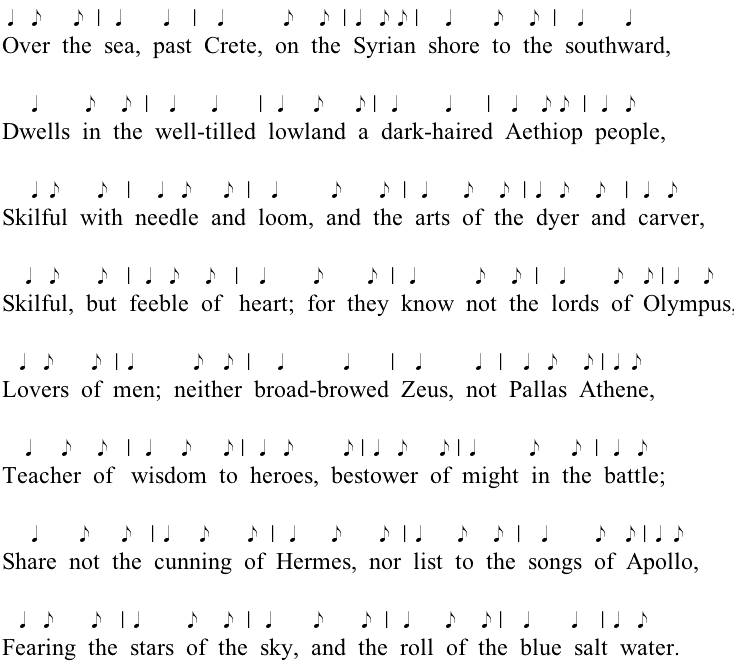
The Oralist approach to Homer (initially developed by Milman Parry in the 1920's and '30's) works from the fact that numerous patronymics and other epithets and epithet phrases are frequently repeated in the Iliad and Odyssey. Also, there are some apparent duplications - typical of orally composed poetry -, such as the terms "Achaian", "Argive", and "Danaan", all referring to the Greeks fighting at Troy.
With considerable oversimplification, Parry's explanation of these repeated phrases, etc. is that they are characteristic of orally composed poetry. In some way, they give the singer a chance to plug in a familiar phrase while he thinks ahead to how he will compose the next line or so. Accordingly, a consistently rhythmical poem can be fairly readily composed orally - and also more or less extemporaneously.
Overall, Lattimore's translation (1951) gives a reasonably good view of the way Homeric repetition works. Besides the print version, this translation (but not Lattimore's introduction) is available online through the Chicago Homer . (This is a very useful site, but perhaps somewhat hard to navigate.)
IL.1.1 SING, goddess, the anger of Peleus' son Achilleus
IL.1.2 and its devastation, which put pains thousandfold upon the Achaians,
IL.1.3 hurled in their multitudes to the house of Hades strong souls
IL.1.4 of heroes, but gave their bodies to be the delicate feasting
IL.1.5 of dogs, of all birds, and the will of Zeus was accomplished
IL.1.6 since that time when first there stood in division of conflict
IL.1.7 Atreus' son the lord of men and brilliant Achilleus.
IL.1.8 What god was it then set them together in bitter collision?
IL.1.9 Zeus' son and Leto's, Apollo, who in anger at the king drove
IL.1.10 the foul pestilence along the host, and the people perished,
IL.1.11 since Atreus' son had dishonoured Chryses, priest of Apollo,
IL.1.12 when he came beside the fast ships of the Achaians to ransom
IL.1.13 back his daughter, carrying gifts beyond count and holding
IL.1.14 in his hands wound on a staff of gold the ribbons of Apollo
IL.1.15 who strikes from afar, and supplicated all the Achaians,
IL.1.16 but above all Atreus' two sons, the marshals of the people:
IL.1.17 ' Sons of Atreus and you other strong-greaved Achaians,
IL.1.18 to you may the gods grant who have their homes on Olympos
IL.1.19 Priam's city to be plundered and a fair homecoming thereafter,
IL.1.20 but may you give me back my own daughter and take the ransom,
IL.1.21 giving honour to Zeus' son who strikes from afar, Apollo.'
The overall pattern of a dactylic hexameter line, then, is the following:

Each measure or foot (1, 2, 3, 4, 5, and 6) can be of the form given above for either line "A" or line "B"; i.e., the whole line can be more or less any mixture of dactyls and spondees; cf. the English and Greek examples on the next page. An entire line of six spondees (which line "B" might seem to illustrate) is, however, extremely unusual.
Dactylic hexameter is not very frequently used in English, but it has occasionally been tried. At one time, a fairly well known example was Longfellow, Evangeline; however, Longfellow's poem is not very much read today. In the context of mythology, an interesting example of English dactylic hexameter is a poem by Charles Kingsley, entitled Andromeda - basically, this is the story of Perseus and Andromeda. Probably most modern treatments of the story - though not the film Clash of the Titans - place Andromeda's family (Cepheus, Cassiopeia, et al.) in Africa. This is the version presented by Apollodorus, J1-2, TSB, pp. 31-33, esp. p. 32. Kingsley, however, follows an alternative version of the story, presented by Conon, 40, TSB, p. 88, which puts Andromeda's family in the Syrian town of Joppa or Ioppa, rather than in Ethiopia proper. (This alternative version is also followed in Clash of the Titans.) Kingley's poem begins as follows:

Likewise, in Greek, the beginning of the Iliad is as follows:

With an attempt at an English dactylic hexameter, one could translate the whole line as follows:

Note that, in the Greek original, this contains the patronymic Pêlêiadeô "son of Peleus". According to the Oralist approach to Homer, the main reason for the appearance of this phrase is that it is a metrically convenient way of expanding the mention of Achilles.
These three designations of the Greeks are metrically distinct, as follows:

According to the Oralist view, all three terms are interchangeable đin oral performance - whichever term is metrically convenient is used - with no real difference in meaning.
Unlike Classical Greek poetry, in which the basic metrical patterns were quantity-based, poetry in English has tended to use stress-based metrical patterns. (Some twentieth and also twenty-first century poetry in English, though, has not utilized any very obvious and/or consistent metrical patterns of any sort.)
As illustrations of stress-based rhythm in poetry in English, the following examples from Hobbes and Pope, both in a fairly strict iambic pentameter, and from Fitzgerald, in a freer, but still recognizable iambic pentameter, may be helpful.
Hobbes:
O Góddess síng what wóe the díscontént
Of Thétis' són bróught to the Greéks; what Sóuls
Of Héroes dówn to Érebús it sént,
Léaving their Bódies únto Dógs and Fówls,
Pope:
Achílles' wráth, to Greéce the díreful spríng
Of wóes unnúmber'd, héavenly góddess, síng!
That wráth which húrl'd to Plúto's gloómy réign
The sóuls of míghty chiéfs untímely sláin;
Fitzgerald:
Ánger be nów your sóng, immórtal óne,
Akhílleus' ánger, doómed and rúinoús,
that cáused the Akhaíans lóss on bítter lóss
and crówded bráve sóuls into the úndergloóm,